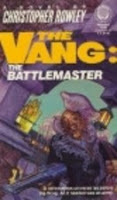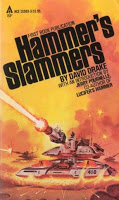One of the standard tropes of 1950’s/60’s science fiction was the Imperial future. That was embodied in Issac Asimov’s Foundation books (as well as many others such as Dune), and was pretty much the standard for many years. In the distant future, the galaxy is ruled by an all-spanning Galactic Empire, where the periphery may be more or less in contact with the center of power, but where the heavy hand of the Empire (or Federation, or whatever it happens to be called) is always there in the background. Gamers will recognize this as the default-type setting in Traveler, as well as PBM games such as Beyond the Stellar Empire. The influence on Star Wars and Star Trek should be obvious. More recently, Thousand Suns uses this as the default type of setting as well.
However, there is another “standard” type of science fiction setting that I would like to tout as an alternative, and in my opinion a better type of setting for gaming purposes. This is the “thousand worlds” setting.
In the Thousand Worlds type setting, there is no central authority in the galaxy. Mankind has spread to the stars, alright, but human culture is much more diffuse and provincial. A government that spans a half-dozen star systems would be considered a major imperial power. Most polities are single systems, or even single worlds or moons within systems, and the laws between worlds vary enormously. In many, Earth is either not mentioned at all or is conveniently removed from the situation. Technology tends to be rather low, compared to what we are familiar with today, with FTL travel and occasionally nods to such things as fusion power being the exception. Aliens are usually few and far between, and when they are present, they are usually human in all but name and skin color.
This is the type of setting of such books as David Drake’s “Hammer’s Slammers” series. The major powers are but a single world in size, albeit engaged in aggressive colonization efforts that tend to rub up against each other, thus providing an excuse for the military conflict that the series showcases. The technology is familiar to anyone who follows the activities of DARPA with any sort of regularity; hovertanks, energy weapons, and so forth. They’re just about the definitive example of military sci-fi, and rightly so.
I should also point out that Hammer’s Slammers has been the subject not only of a hex-and-counter wargame back in the 1980’s, but there are also currently published rules for miniatures battles based on the books and the technology described therein. The latter are a bit pricey for me just at the moment, but I do hope to get a copy someday.
 Christopher Rowley’s “Vang” novels also portray such a future. Each world is an island unto itself (although they do share certain conventions, such as a protocol to deal with anyone who happens to stumble across a Vang artifact). The various books in the series deal with what happens to different worlds when they do stumble across such artifacts (which are, in fact, Vang survivors of an ancient war in which the Vang were nearly obliterated) across the span of thousands of years. But since each world has its own culture, political system, and so forth, each deals with the threat in its own way.
Christopher Rowley’s “Vang” novels also portray such a future. Each world is an island unto itself (although they do share certain conventions, such as a protocol to deal with anyone who happens to stumble across a Vang artifact). The various books in the series deal with what happens to different worlds when they do stumble across such artifacts (which are, in fact, Vang survivors of an ancient war in which the Vang were nearly obliterated) across the span of thousands of years. But since each world has its own culture, political system, and so forth, each deals with the threat in its own way.
The Vang, by the way, are some of the best villains ever created. Not only do they enter a body (through any and all orifices) and control the mind, but they actually control the metabolism to the point of altering its physical form, growing new sensory apparatus (that look like flowers) where the eyes used to be, chitinous exoskeletons, etc. They don’t just control you. You are nothing more than raw biological material. The Borg could learn a thing or two in callousness from the Vang.
 Finally, I would cite George R.R. Martin’s “Thousand Worlds” stories (whence, of course, I took the name for this post), which include not only his excellent “Haviland Tuf” stories, but a number of other excellent examples as well, including what is possibly the best science fiction short story ever written; “Sandkings”. Again, each world is its own government, often with very different cultures and mores than their neighbors. Sometimes they war, often they trade, usually they collide in some way or other. You go from one star system to another, and you might find the rights to your salvaged derelict space ship have changed dramatically. The vast Federal Empire is but a distant memory, and the various colony planets of humanity have gone their own way, and Earth itself is under a self-imposed quarantine, guardian of some of the last technologies of the Earth Imperials, so there’s more than a little of the Lost Golden Age aspect to this particular setting as well. I can only hope that once the Game of Thrones series ends, Mr. Martin will return to this setting, and in particular the Haviland Tuf stories.
Finally, I would cite George R.R. Martin’s “Thousand Worlds” stories (whence, of course, I took the name for this post), which include not only his excellent “Haviland Tuf” stories, but a number of other excellent examples as well, including what is possibly the best science fiction short story ever written; “Sandkings”. Again, each world is its own government, often with very different cultures and mores than their neighbors. Sometimes they war, often they trade, usually they collide in some way or other. You go from one star system to another, and you might find the rights to your salvaged derelict space ship have changed dramatically. The vast Federal Empire is but a distant memory, and the various colony planets of humanity have gone their own way, and Earth itself is under a self-imposed quarantine, guardian of some of the last technologies of the Earth Imperials, so there’s more than a little of the Lost Golden Age aspect to this particular setting as well. I can only hope that once the Game of Thrones series ends, Mr. Martin will return to this setting, and in particular the Haviland Tuf stories.
I find this sort of setting somewhat more useful for gaming purposes than the Imperial setting, simply because of the diversity that is implicit within it. While it is certainly possible to derive wonder and conflict in any sort of setting, even the most locked-down Galactic Empire, the Thousand Worlds type setting seems to be implicitly built on such diversity and conflict. I personally also like the lower levels of technology that such settings usually employ; the people there could be anyone from our contemporary world, with FTL drive. In such settings, even thousands of years into the future, it’s still guns and wheels, and I kinda like that for a game setting.











Note also that there is a bit of a blend occasionally as well. In Traveller, for instance, there are the large imperial states, such as the Imperium, the Aslan Hierate, the Zhondani Consulate. However, ther are areas like the Vargr Extents and the Sword Worlds.
Also, the Imperium itself has control over "space" but not over individual planets. So, planets within the Imperium can still be somewhat diverse while using Imperial Standard technology.
Have you ever read Matthew Hughes? Some of his novels have a "Thousand Worlds" feel with a more modern sensibility.
Bujold's Vorkosigan series uses the single planet or small chain of planets type of setting.
My favorite is H.Beam Piper's future history (bits of which TRAVELLER seems to have annexed).
The ships pound on each other with guns and missiles with nuclear weapons aplenty. The ground forces have contra-gravity but still fight with machine guns (and nuclear weapons). Both Federation and Empire have risen in his stories and fallen to a time when it is single planet empires again.
JasonZavoda~ Those are some very interesting observations. Very nice article & an interesting way to exploit the book value on these! Seriously these are some great books for mostly any old school science fiction rpg game.
Thanks for the thought-provoking article. Now that you've presented the distinction between a multi-star empire and a thousand suns setting, I too prefer the thousand suns approach. It always seemed to be stretching credibility to propose that a single governing body was able to maintain a cohesive control over so many planets.
Yeah. I think I would hesitate to classify the Third Imperium as either. Sure, there’s this massive interstellar empire, but as Anthony notes, the individual systems are still pretty independent. How much power the Imperium really wields varies from referee to referee.
Dagnabbit, the recent Blogger.com troubles seem to have eaten the comments on this post. If they don't magically re-appear, I'll see what I can do about reposting them manually from the email notifications I get.
I assume you've seen Stars Without Number, which uses this trope?